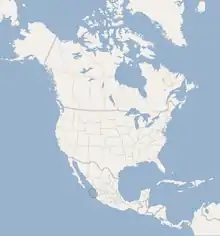Findley's myotis
Findley's myotis (Myotis findleyi) is a species of vesper bat. It is found only on the Tres Marías Islands off the west coast of Mexico.
| Findley's myotis | |
|---|---|
| Scientific classification | |
| Kingdom: | Animalia |
| Phylum: | Chordata |
| Class: | Mammalia |
| Order: | Chiroptera |
| Family: | Vespertilionidae |
| Genus: | Myotis |
| Species: | M. findleyi |
| Binomial name | |
| Myotis findleyi Bogan, 1978 | |
 | |
Taxonomy and etymology
This species was first encountered by Alphonse Forrer in the late 19th century. The specimen he collected was described by Oldfield Thomas as a member of the black myotis (Myotis nigricans).[2] In 1928, the specimen collected by Forrer was identified as the California myotis (Myotis californicus).[3] In 1978, the Myotis bats of Tres Marías Islands were elevated to species level, receiving the name Myotis findleyi.[4] It was given the species name findleyi to honor James Smith Findley, a mammalogist and the former Curator of Mammals at the University of New Mexico Museum of Southwestern Biology.[5] Findley was honored "in recognition of his work on bats of the genus Myotis."[4]
Description
It is one of the smallest bats in its genus in the New World.[4] In mass, it is only 2–3 g (0.071–0.106 oz)[6] In total, it is 70–80 mm (2.8–3.1 in) long. Their forearms are 29.5–33.2 mm (1.16–1.31 in) long. Their dorsal fur is dark brown to brownish-black in color. Individual hairs have frosted tips at the distal third of the hair, while the proximal two-thirds of the hairs are dark brown or black. Individual dorsal hairs are 8 mm (0.31 in) long. Their ventral fur is also bicolored; the base of the hair is black, while the tips are buffy. The uropatagium is furred on the ventral surface. Wing membranes are dark brown in color. The keel of the calcar is indistinct. Their feet are relatively large in proportion to their body size at 6.6 mm (0.26 in), and all their toes have sparse hairs. Their ears are relatively small, measuring 11.9 mm (0.47 in) long. Ears have a pronounced notch at the base, and are dark brown in color. The tragus is 5.5 mm (0.22 in) long, and pointed at the tip.[4] Its dental formula is 2.1.3.33.1.3.3, for a total of 38 teeth.[6]
Biology
It is insectivorous.[7][6] So far, it has only been captured by placing mist nets over streams and pools. It is unknown if it roosts in caves or tree hollows during the day.[1]
Range and habitat
It is only found in the tropical deciduous forests of the Tres Marías Islands. It is found from 0–600 m (0–1,969 ft) above sea level.[6]
Conservation
This species is listed as endangered by the IUCN. It is listed as endangered because its extent of occurrence is approximately 900 km2 (350 sq mi), and it occurs in fewer than five locations. There is also a projected decline in the extent and quality of their habitat. Threats to this species include urbanization, livestock farming, deforestation, and invasive species. Some of the bat's habitat is protected, as their range includes Islas Marías Biosphere Reserve. Some of its range also occurs on property owned by Islas Marías Federal Prison.[1]
References
- Arroyo-Cabrales, J. & Ospina-Garces, S. 2016. Myotis findleyi. The IUCN Red List of Threatened Species 2016: e.T14159A22058800. https://dx.doi.org/10.2305/IUCN.UK.2016-1.RLTS.T14159A22058800.en. Downloaded on 27 September 2017.
- Thomas, Oldfield. 1882. Biologia Centrali-Americana, Mammalia, Supplement. Notes on various species of mammals found on the Tres Marias: Vesperugo paruulus, p. 203; Atalapha noveboracensis, p. 205; Vespertilio nigricans, p. 206; Macrotus waterhousii, p. 207; Charonycteris mexicana [= Glossophaga mutica], p. 207; Procyon cancrivorus, p. 208; Lepus graysoni, p. 211.
- Miller, G. S., & Allen, G. M. (1928). The American bats of the genera Myotis and Pizonyx (Vol. 144). US Government Printing Office.
- Bogan, M. A. (1978). A new species of Myotis from the Islas Tres Marias, Nayarit, Mexico, with comments on variation in Myotis nigricans. Journal of Mammalogy, 59(3), 519-530.
- Beolens, B., Watkins, M., & Grayson, M. (2009). The Eponym Dictionary of Mammals. JHU Press.
- Ceballos, G. (Ed.). (2014). Mammals of Mexico. JHU Press.
- Nowak, R. M. (1999). Walker's mammals of the world (Vol. 1). JHU Press.
